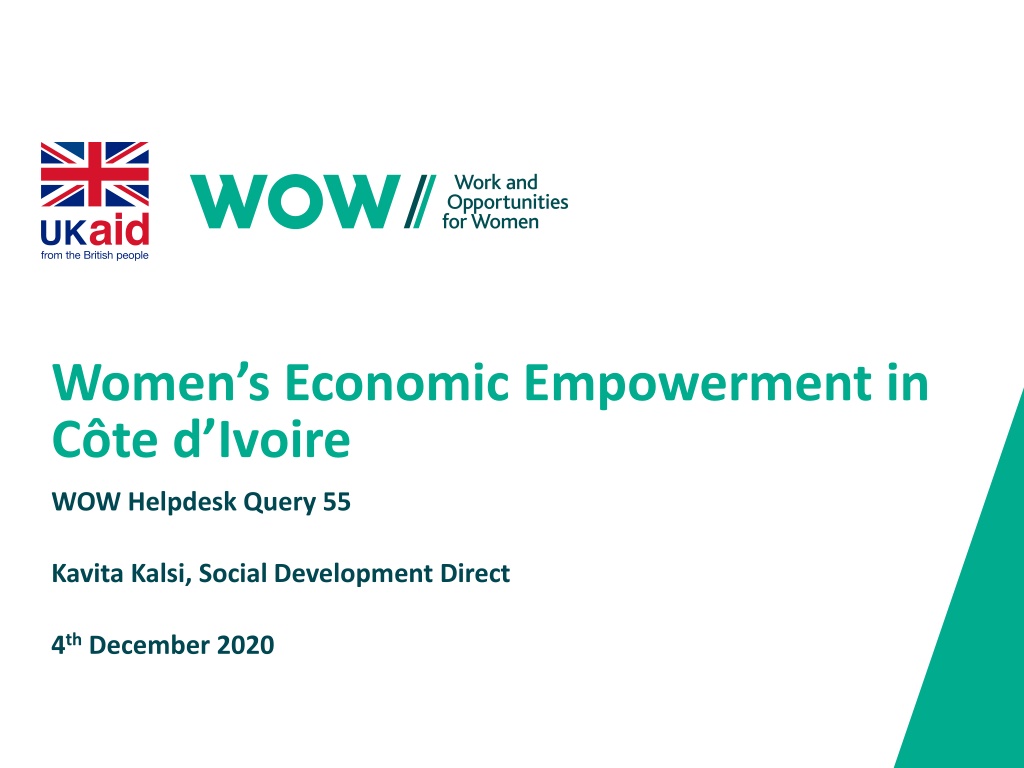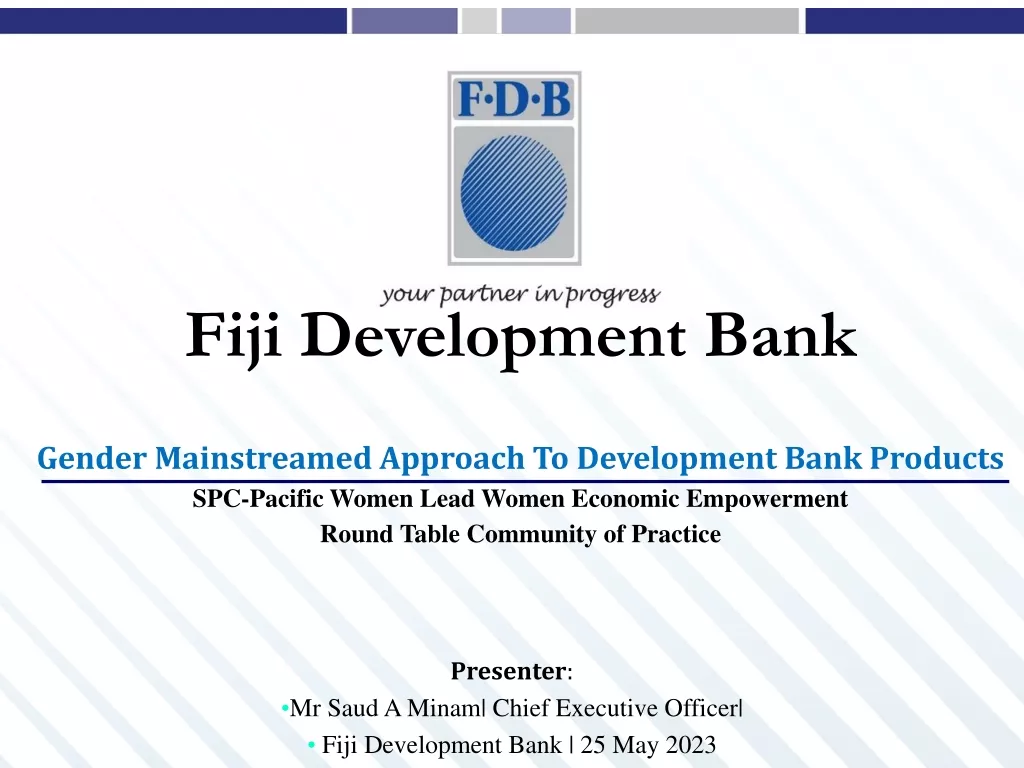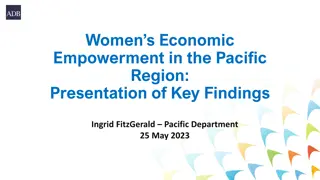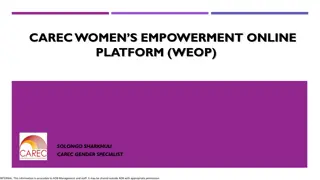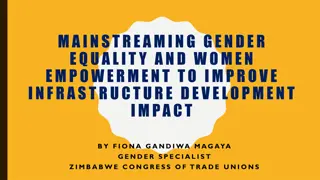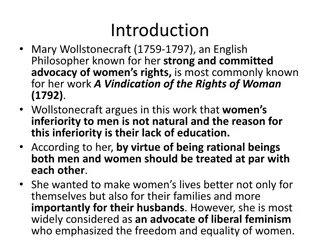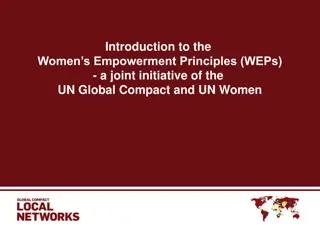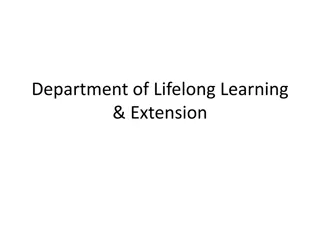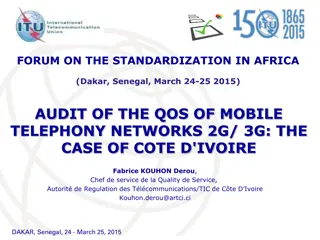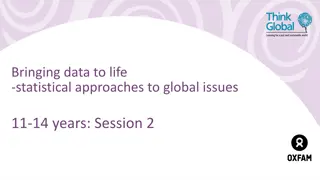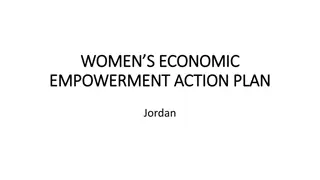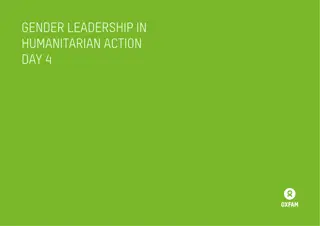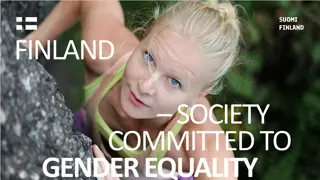Understanding Women's Economic Empowerment in Côte d'Ivoire
This document delves into the critical issues surrounding women's economic empowerment in Côte d'Ivoire, highlighting the disparity between men and women, key economic policies, and potential strategies for intervention. It provides insights into the country's economic landscape, gender inequalities, workforce composition, sector analysis, and legislative framework affecting women's empowerment.
Download Presentation

Please find below an Image/Link to download the presentation.
The content on the website is provided AS IS for your information and personal use only. It may not be sold, licensed, or shared on other websites without obtaining consent from the author. Download presentation by click this link. If you encounter any issues during the download, it is possible that the publisher has removed the file from their server.
E N D
Presentation Transcript
Womens Economic Empowerment in C te d Ivoire WOW Helpdesk Query 55 Kavita Kalsi, Social Development Direct 4thDecember 2020
OFFICIAL Query objective and questions Objective To increase understanding of the reasons behind economic disparity between men and women in C te d Ivoire - as well as the country s economic policies to inform HMG work with the government of C te d Ivoire on the design and roll-out of WEE-sensitive interventions. Questions 1. What are the critical issues for women s economic empowerment in C te d Ivoire? 2. What analysis has been conducted on economic growth and key economic policies in C te d Ivoire, and their application and impact on women s economic empowerment? 3. What entry points are there for strengthening women s economic empowerment in C te d Ivoire from a policy influencing, legislative and programming perspective, considering the government s core objective of fostering a demographic transition and dividend? 2 | Document Title
FCDO Women s Economic Empowerment Conceptual Framework
OFFICIALFCDO Womens Economic Empowerment Conceptual Framework 4 | Document Title
Question 1: Critical issues for women s economic empowerment in C te d Ivoire
OFFICIAL Overview: One of the fastest growing economies but some of the highest gender inequality in the world 8% of women compared to 22% of men with land titles Workforce comprises 49.3% women and 66.9% men Primary completion is 75.1% for girls to 82.3% for boys 36% of women report experience of domestic violence Women hold 11% of seats in the National Assembly Score of 83/100 on Women Business and Law indicators Fertility rate is 5.1 births and 18% of women access contraceptives 6 | Document Title
OFFICIAL Sector analysis The largest proportion of women work in agriculture (42.9%) then retail (31.6%) then domestic work (9.6%). Manufacturing currently engages only a small proportion of women (1.8% in the garment sector and 1.0% in other industrial sectors). But industrial development is a core element of C te d Ivoire s National Development Plan 2016- 2020. 7 | Document Title
OFFICIAL Breakdown of sectors by gender Men Women Proportion women of TOTAL Agriculture Forestry, fodder activities 2,586,158 92,827 47.8% 1.7% 1,751,601 21,335 42.9% 0.5% 40.4% 18.7% 4,337,759 114,162 45.7% 1.2% Breeding, hunting, fishing 73,252 1.4% 6,709 0.2% 8.4% 79,961 0.8% Agrifoods industries 37,851 0.7% 15,357 0.4% 28.9%. 53,208 0.6% Garment production 80,240 1.5% 74,538 1.8% 48.2% 154,778 1.6% Other industrial activities 241,982 4.5% 39,418 1.0% 14.0% 281,400 3.0% Construction Retail Wholesale Repair services Hospitality Transport et communication 147,662 663,000 101,218 168,162 63,767 327,486 2.7% 12.3% 1.9% 3.1% 1.2% 6.1% 3,551 1,290,090 155,596 4,638 136,816 24,235 0.1% 31.6% 3.8% 0.1% 3.3% 0.6% 2.3% 66.1% 60.6% 2.7% 68.2% 6.9% 151,213 1,953,090 256,814 172,800 200,583 351,721 1.6% 20.6% 2.7% 1.8% 2.1% 3.7% Domestic services Administration, social services 284,534 538,698 5.3% 10.0% 393,259 168,169 9.6% 4.1% 58.0% 23.8% 677,793 706,867 7.1% 7.4% Total 5,406,838 100.0% 4,085,312 100.0% 43.0% 9,492,150 100.0% 8 | Document Title
OFFICIAL Agriculture Access to land Lack of access to land is a critical barrier to women s economic empowerment Lack of access to land restricts access to credit Widows are vulnerable to losing land access upon the death of their husband Migrant women (both foreign and from other regions of C te d Ivoire) face barriers to land access Productivity Women dominate in food crops But are often excluded from cash crops Cashew nuts and cotton are grown in the North and Centre. Some women produce these but are limited by labour and land needs Cocoa, coffee, rubber and palm oil are grown in the South, East and West. Women represented 6% of cocoa growers in 2015-2020, though they carry out unpaid labour as wives of growers 32% reduction in the gender gap in productivity in both crop types between 2008 and 2016 due to women farmers increased use of fertilizer/pesticide 9 | Document Title
OFFICIAL Entrepreneurship Women comprise 20% of business directors and 20 out of 430 directors of large companies Women make up 62% of self-employed individuals mainly in rural and informal economies Women entrepreneurship is seen as a motor for growth contributed approx. 62.4m West African CFA to the economy in 2014. Government financing instruments are in place but have led to repayment debts for women entrepreneurs Barriersrestricting women entering the formal economy: lack of training in financial management high rates of female illiteracy failure to institutionalise gender-sensitive budgeting weakness of finance mechanisms for women s empowerment projects insufficient approach to gender and development in national and local planning 10 | Document Title
OFFICIAL Access to finance Financial inclusion is weak for both men and women in 2017, 14.8% of the population had an account with a financial institution Mobile money services are increasing women s access to financial services but gender gaps remain women are 45% less likely than men to have a mobile money account Barriers to women s access to mobile money services include lack of mobile phone access and financial innumeracy 11 | Document Title
OFFICIAL Service sector Informal retail: Is a principal source of employment for women particularly migrant women due to fewer barriers to entry Targeting informal retail would be an effective way to reach migrant women excluded from other sectors Domestic work: High participation amongst 18-35 year-olds across all ethnicities and a key driver of rural to urban migration and immigration from surrounding countries Hospitality: Access depends on education level poorer and migrant women are less well represented. . 12 | Document Title
OFFICIAL Manufacturing Women s participation is currently low, but industrialisation is a key growth area Opportunities vary by region: North and Centre: cashew nuts, mangos, yams, cassava, honey, and shea butter processing are likely to be prioritised; West and South: consumer electronics, palm oil, cassava, bananas, fish and snail farming The snail market is thriving as it is a reliable source of protein and requires low farming inputs (and can be done from home) potential for further investment 13 | Document Title
Question 2: Review of analysis of economic growth and key economic policies in C te d Ivoire and their application and impact on women s economic empowerment
OFFICIAL Economic growth and development plans Before COVID-19, Cote d Ivoire had one of the most robust growth rates in Africa and the world its economy has grown by 8% every year since 2012 (projections are now 1.8% due to the pandemic) The C te d Ivoire National Development Plan 2016-2020 highlights priorities for structural reforms: Creation of a world class business environment, including institutional reform; Increased involvement of international actors in the economy; Formalising the informal economy; Modernising micro- and small/medium enterprises, particularly to boost opportunities for youth. 15 | Document Title
OFFICIAL Economic growth gains have been uneven Gains have not translatedinto gains in women s economic empowerment: C te d Ivoire scores 0.545 on the Global Gender Gap economic participation and opportunity sub-index lower than the Sub- Saharan African average (0.666) It has closed only 54.5% of its gender gap in this sub-index in contrast to regional counterpart Benin (84.7%) and the Sub- Saharan African average (68.0%) Labour force participation rate is 49.3% for females compared to 66.9% for males, whilst women face higher rates of unemployment (9.4%) compared to men (4.5%) 16 | Document Title
OFFICIAL Limited focus on women s economic empowerment The National Development Plan 2016-2020 highlights women s empowerment, autonomy and decision making: Helped build support for the passing of the 2019 Marriage Law that gives women equal property rights; Put in place the FAFCI support fund for all Ivorian women who have a project to develop; Requires all political parties to have 30% female representation in decision- making role although this has not yet been implemented The government also provides support to women to access pesticide but only for groups of women farmers, not individuals unless they are land owners (only 1% of women, usually widows) The government is criticised for its level of response to the Beijing Platform for Action +25 agenda with insufficient gender in local and national planning and budgeting as well as insufficient access to finance for women 17 | Document Title
Question 3: Entry points for strengthening women s economic empowerment in C te d Ivoire
OFFICIAL Key recommendations Domain Examples Work Policies that encourage women to enter the cash crop sector eg by facilitating access to cash crop markets Challenge occupational segregation in agriculture Policies that provide more flexible economic support to women entrepreneurs Support women s entrepreneurship Ensure consultation with women s organisations to understand their needs regarding industrialisation and economic empowerment during the drafting of the 2021-2025 National Development Plan Support C te d Ivoire s drive towards industrialisation whilst promoting women s economic empowerment Assets Support women s access to and control over land Policies that encourage women from different ethnic groups to form inter-ethnic women s organisations which work together to access land 19 | Document Title
OFFICIAL Key recommendations Domain Examples Gender specific constraints and enablers Ensure consultations with women representative organisations and focus on priorities for women in the National Development Plan 2021-2025 A focus on improving outcomes for women via gender-friendly audit/analysis Challenge harmful social norms around women s land rights Consider funding the employment and training of paralegals to assist rural women in asserting and securing their land rights Support programmes that challenge social norms around the allocation of care to reduce women s unpaid care work thereby giving women more time for farming/other profitable work Reduce women s domestic chores and unpaid care 20 | Document Title
OFFICIAL For further information, please contact: For further information, please contact: Kavita Kalsi, Senior Technical Specialist Social Development Direct m: 00 44 203 948 1985 e: kavita.kalsi@sddirect.org.uk WOW Helpdesk e: enquiry@WOWHelpdesk.org.uk t: +44 (0)203 735 6416 The WOW Helpdesk is available 9:30am 17:30pm (UK time) Monday to Friday. Disclaimer to go in here
This document is an output from a project funded by UK aid from the UK government. However, the views expressed and information contained in it are not necessarily those of or endorsed by the UK government who can accept no responsibility for such views or information or for any reliance placed on them. This publication has been prepared for general guidance on matter of interest only, and does not constitute professional advice. The information contained in this publication should not be acted upon without obtaining specific professional advice. No representation or warranty (express or implied) is given as to the accuracy or completeness of the information contained in this publication, and, to the extent permitted by law, no organisation or person involved in producing this document accepts or assumes any liability, responsibility or duty of care for any consequences of anyone acting, or refraining to act, in reliance on the information contained in this publication or for any decision based on it.
